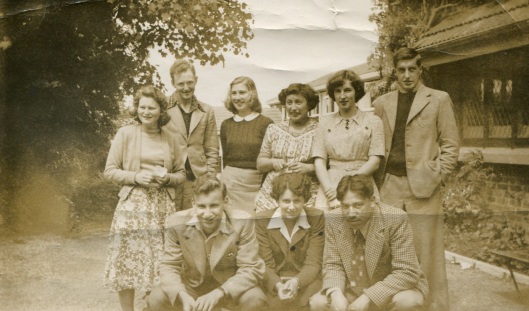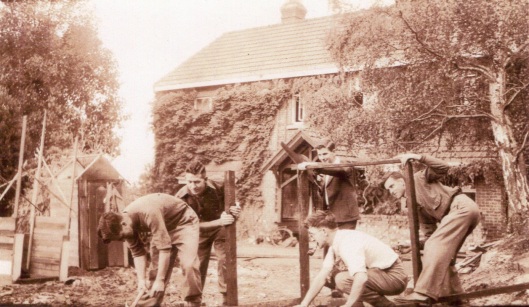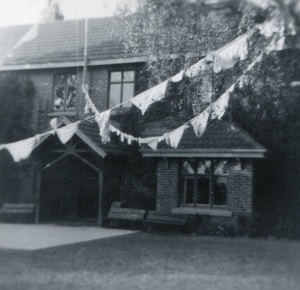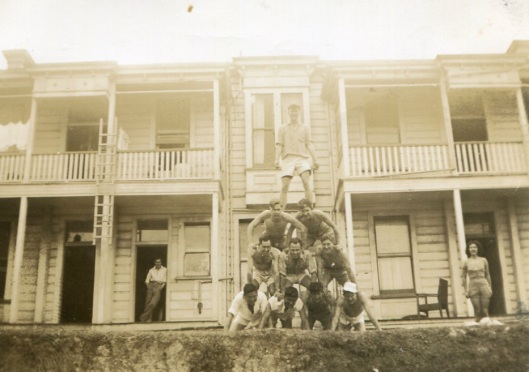Tags
1940s, 1950s, 1960s, 1970s, 1980s, Arana, Carrington, Stuart House

A happy group of Carrington residents in the late 1940s. Standing (left to right): ?, D Whalan, ?, B Pohe, N Parris, R Williams. At front right is Ben Whitiwhiti. Image courtesy of Bill Dawson, from an album of Robin Cook.
When Carrington opened 70 years ago it had one major difference from Otago’s older residential colleges – it welcomed both men and women. That was pretty radical for the 1940s, and for a few years Carrington was Australasia’s only ‘co-residential’ student hall of residence.
The Stuart House Council’s decision to run a mixed residence was a pragmatic response to the needs and opportunities of the time. It evolved out of a successful experiment at their earlier student residence, Stuart House, which was absorbed into the new Carrington. In 1940 Harold Turner, the assistant minister at Knox Church, where many parishioners were students, came up with the idea of opening a small student hostel in the former Presbyterian Women’s Training Institute at 638 Cumberland Street (where one end of the Student Union is now). He formed a committee with several other enthusiasts, among them George Carrington (secretary of the Otago Education Board) and successful businessmen Cecil Wardell (of the flourishing Wardell’s grocery firm) and Gifford Laurenson (of the equally flourishing bakery firm). Turner later described them as ‘a private voluntary group on a religious but interdenominational basis’.
In 1941 Stuart House, as they renamed the Cumberland Street property, opened to 29 men, some of them accommodated in an ‘annexe’ at the former Training College building across the road (now part of the physical education school). In 1942, with many male students headed off for military service but an influx of women students, the council decided to change Stuart House to a women’s residence. Since some men had already been offered places, they found bedrooms for them in private homes nearby but kept them as ‘associate members’ of Stuart House, which they attended for meals and social activities. This makeshift arrangement proved unexpectedly successful; it was popular with the residents and Turner, the warden, was pleased that the house was ‘much quieter and more orderly than it was last year’.
With no shortage of demand for student accommodation, the Stuart House Council always had an eye out for suitable buildings which might be converted. In 1942 they persuaded the university to purchase Arana, the home of the late Sir James Allen, and lease it to them. It opened as a residence for men in 1943. In late 1944 another good property, located on Heriot Row, came on the market. Carrington bought it on spec, having heard a rumour that the government was planning to provide money for teachers’ college student accommodation. Fortunately this proved correct, and after some delay the Otago Education Board funded the building, leaving its management in the hands of the council (now named the Stuart Residence Halls Council). Like Stuart House and Arana, Carrington was open to both university and teachers’ college students.

Building a float for the 1946 capping procession, in front of the first house purchased for Carrington. The man with saw in hand is Murray Menzies, who became a surgeon. Image from Pat Menzies, courtesy of Carrington College.
Students moved into the new Carrington Hall in 1945 – women into the former Halstead property and men into one of the two neighbouring houses the council had purchased. The generous grounds of the old houses provided room for yet more accommodation and in 1947 a brand new wing named Stuart House opened, along with more temporary buildings made from army huts. In that year Carrington provided a home for 105 students, being 53 men and 52 women. The original Stuart House in Cumberland Street became flats in 1947; the council sold the building in 1952.

Even the laundry was once segregated! A photo taken by 1953-4 resident Lex Familton after a raid on the women’s drying room. Image courtesy of Carrington College.
So, the radical experiment in accommodating women and men in the same residential college happened rather by accident, but since it proved a success it was allowed to continue. Of course the liberals of the 1940s weren’t quite as liberal as those of later generations, and there were strict rules about the mixing of men and women at Carrington. They could socialise freely in the communal spaces, but for the first few decades they had segregated bedroom wings/houses. Until 1976 all of the wardens were clergymen, some more conservative than others. Legend has it that one warden and his wife would listen in at the men’s doors to ensure any women had left before 7p.m. In 1973 the integration of buildings commenced, though men and women still had separate floors for many years.
Turner wrote in the 1950s about the advantages of mixed residences, where the sexes could socialise in a ‘natural and happy’ way and form ‘decent and sensible friendships’. Pranks and raids were less extreme than in some of the men’s colleges and, overall, it made ‘the men less crude, and the girls less giggly’. Co-residence could be ‘too distracting for some students’, though, suggested Turner, and some argued that it was ‘good for men to spend some years in a thoroughly masculine environment; presumably the parallel position is true of women’.
Though some university authorities got pretty het up about mixed flatting in the 1960s, they saw the advantages of mixed residential colleges, especially as the number of women students grew and eventually overtook the number of men. University College (Unicol) opened in 1969 as another mixed residence, albeit with men and women living in separate towers for many years. During the 1970s Studholme, Salmond, Arana and Aquinas all went co-ed, St Margaret’s joined the trend in 1981, and in 1983 the oldest colleges – Selwyn and Knox – finally and controversially lost their positions as bastions of masculinity (some would say chauvinism!).

Gymnastics at Carrington, from the album of Robin Cook, a resident of the late 1940s. Image courtesy of Bill Dawson.
Meanwhile, the trailblazer Carrington continued on its happy way as a residence open to all. As neighbouring properties came on the market they were absorbed into the college, which now provides accommodation for around 240 students in an attractively landscaped collection of 11 buildings, some of them refurbished large old homes and some of them purpose-built. The Stuart Residence Halls Council eventually sold both Carrington and Arana to the university, which now directly manages these colleges. With the funds obtained, the council then made very generous gifts back to the university, endowing the Stuart Chair in Science Communication and the Stuart Chair in Scottish Studies.
Do you have any memories to share of the early decades of Carrington? Can you identify anybody in the photographs? If so, I’d love to hear from you!

Pingback: Rounding off 2015 | University of Otago 1869-2019